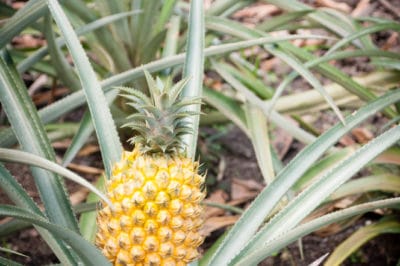Production
Serious home producers have dozens of plants at different stages of growth for a steady supply. Once fruiting each plant will produce a fruit per year. Most commercial growers will pull the plant out after one or two years of production. Small slips grow off the sides of mature plants. These are used to propagate more plants.
Commerical pineapple production is not a sustainable or eco-friendly practice. Costa Rice and Brazil are the worlds largest pineapple producers. The production is highly industrialized, dependent upon fossil fuels and chemical inputs.
Employees and residents are exposed to pesticides, fungicides, and nitrate fertilizers that wash into waterways and drift through the air. All the more reason to grow your own organic pineapples.
How To Tell If It’s Ripe
Size is not a good indicator of ripeness. Depending on growing conditions, the age and variety of the plant, and the season the size could be vastly different.
Instead, use your other senses to investigate the fruit.
- Fruitlets: Each of the individual fruitlets on the rind of the pineapple will flatten as the fruit ripens.
- Color: Pineapples will turn from green to yellow as they ripen, the process moves from the bottom up.
- Smell: Ripe pineapples smell sweet, fruity, and floral.
- Weight: Fruits tend to gains significant weight in the last few weeks of ripening.
- Sound: Tap the fruit rind and listen for a hollow sound which is a good indicator that it’s ripe.
Will They Ripen Off Plant?
Pineapples will continue to ripen off the plant to a degree. The flavor won’t improve, but they will continue to get sweeter after picking. As a general rule, a pineapple that is 1/3 yellow is ready for harvest and counter ripening.
If you intend to eat the fruit right away, there’s no reason to pick them early. Let the fruit turn yellow on the plant and harvest for the best flavor rather than shelf-life.
How To Harvest
Use a sharp knife or machete that has been sanitized to discourage disease spreading. Cut the pineapple off of the plant at the base. Leave one inch of stem attached to the fruit. Avoid damaging the remaining stem on the plant so that it will continue to live and produce fruit.
